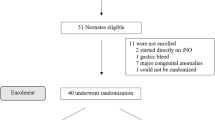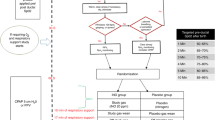Abstract
Objective
To investigate the acute effects of intravenous sildenafil on haemodynamics and oxygenation, and its interaction with inhaled nitric oxide (iNO) in infants at risk of pulmonary hypertension early after cardiac surgery.
Design
Prospective, randomised trial.
Setting
Paediatric intensive care unit of a children’s hospital.
Patients and participants
Sixteen ventilated infants early after closure of ventricular or atrioventricular septal defects, were randomly assigned to one of two groups. The study was completed in 15 infants.
Interventions
Studies were commenced within 7 h of separation from bypass. Seven infants received iNO (20 ppm) first, with the addition of intravenous sildenafil (0.35 mg/kg over 20 min) after 20 min. Eight infants received sildenafil first, iNO was added after 20 min. Vascular pressures, cardiac output and a blood gas were recorded at 0, 20 and 40 min.
Measurements and results
In infants receiving iNO first, iNO lowered the pulmonary vascular resistance index (PVRI) from 3.45 to 2.95 units (p=0.01); sildenafil further reduced PVRI to 2.45 units (p<0.05). In those receiving sildenafil first, PVRI was reduced from 2.84 to 2.35 units (p<0.05) with sildenafil, and fell to 2.15 units (p=0.01) with the addition of iNO. In both groups, sildenafil reduced the systemic blood pressure and systemic vascular resistance (p<0.01) and worsened arterial oxygenation and the alveolar-arterial gradient (p<0.05).
Conclusion
Intravenous sildenafil augmented the pulmonary vasodilator effects of iNO in infants early after cardiac surgery. However, sildenafil produced systemic hypotension and impaired oxygenation, which was not improved by iNO.



Similar content being viewed by others
References
Clark RH, Kueser TJ, Walker MW, Southgate WM, Huckaby JL, Perez JA, Roy BJ, Keszler M, Kinsella JP (2000) Low-dose nitric oxide therapy for persistent pulmonary hypertension of the newborn. N Engl J Med 342:469–474
Goldman AP, Delius RE, Deanfield JE, de Leval MR, Sigston PE, Macrae DJ (1996) Nitric oxide might reduce the need for extracorporeal support in children with critical postoperative pulmonary hypertension. Ann Thorac Surg 62:750–755
Shekerdemian LS, Ravn HB, Penny DJ (2002) Intravenous sildenafil lowers the pulmonary vascular resistance in a model of neonatal meconium aspiration. Am J Respir Crit Care Med 165:1098–1102
Abrams D, Schulze-Neick I, Magee AG (2000) Sildenafil as a selective pulmonary vasodilator in childhood primary pulmonary hypertension. Heart 84 (2):E4
Prasad S, Wilkinson J, Gatzoulis MA (2000) Sildenafil in primary pulmonary hypertension. N Engl J Med 343:1342
Ghofrani HA, Wiedemann R, Rose F, Schermuly RT, Olschewski H, Weissmann N, Gunther A, Walmrath D, Seeger W, Grimminger F (2002) Sildenafil for treatment of lung fibrosis and pulmonary hypertension: a randomised controlled trial. Lancet 360:895–900
Michelakis E, Tymchak W, Lien D, Webster L, Hashimoto K, Archer S (2002) Oral Sildenafil is an effective and specific pulmonary vasodilator in patients with pulmonary arterial hypertension: comparison with inhaled nitric oxide. Circulation 105:2398–2403
Brown KL, Ridout DA, Goldman AP, Hoskote A, Penny DJ (2003) Risk factors for long intensive care unit stay after cardiopulmonary bypass in children. Crit Care Med 31:28–33
Schulze-Neick I, Li J, Penny DJ, Redington AN (2001) Pulmonary vascular resistance after cardiopulmonary bypass in infants: effect on postoperative recovery. J Thorac Cardiovasc Surg 121:1033–1039
Celermajer DS, Cullen S, Deanfield JE (1993) Impairment of endothelium-dependent pulmonary artery relaxation in children with congenital heart disease and abnormal pulmonary hemodynamics. Circulation 87:440–446
Seghaye MC, Duchateau J, Bruniaux J, Demontoux S, Detruit H, Bosson C, Lecronier G, Mokhfi E, Serraf A, Planche C (1997) Endogenous nitric oxide production and atrial natriuretic peptide biological activity in infants undergoing cardiac operations. Crit Care Med 25:1063–1070
McMullan DM, Bekker JM, Parry AJ, Johengen MJ, Kon A, Heidersbach RS, Black SM, Fineman JR (2000) Alterations in endogenous nitric oxide production after cardiopulmonary bypass in lambs with normal and increased pulmonary blood flow. Circulation 102:III-172–178
Bando K, Vijayaraghavan P, Turrentine MW, Sharp TG, Ensing GJ, Sekine Y, Szekely L, Morelock RJ, Brown JW (1997) Dynamic changes of endothelin-1, nitric oxide and cyclic GMP in patients with congenital heart disease. Circulation 96:II-346–351
Schulze-Neick I, Penny DJ, Rigby ML, Morgan C, Kelleher A, Collins P, Li J, Bush A, Shinebourne EA, Redington AN (1999) L-arginine and substance P reverse the pulmonary endothelial dysfunction caused by congenital heart surgery. Circulation 100:749–755
Asimakopoulos G, Smith PL, Ratnatunga CP, Taylor KM (1999) Lung injury and acute respiratory distress syndrome after cardiopulmonary bypass. Ann Thorac Surg 68:1107–1115
Schulze-Neick I, Li J, Shekerdemian LS, Redington AN, Penny DJ (2002) The endothelin antagonist BQ123 reduces pulmonary vascular resistance in infants after congenital heart surgery. J Thorac Cardiovasc Surg 124:435–441
Miller OI, Tang SF, Keech A, Pigott NB, Beller E, Celermajer DS (2000) Inhaled nitric oxide and prevention of pulmonary hypertension after congenital heart surgery: a randomised double-blind study. Lancet 356:1464–1469
Kleinsasser A, Loeckinger A, Hoermann C, Puehringer F, Mutz N, Bartsch G, Lindner KH (2001) Sildenafil modulates hemodynamics and pulmonary gas exchange. Am J Respir Crit Care Med 163:339–343
Jackson G, Benjamin N, Jackson N, Allen MJ (1999) Effects of sildenafil citrate on human hemodynamics. Am J Cardiol 83:13C-20C
Walker DK, Ackland MJ, James GC, Muirhead GJ, Rance DJ, Wastall P, Wright PA (1999) Pharmacokinetics and metabolism of sildenafil in mouse, rat, rabbit, dog and man. Xenobiotica 29:297–310
Weintraub RG, Brawn WJ, Venables AW, Mee RB (1990) Two-patch repair of complete atrioventricular septal defect in the first year of life. Results and sequential assessment of atrioventricular valve function. J Thorac Cardiovasc Surg 99:320–326
Bando K, Turrentine MW, Vijay P, Sharp TG, Sekine Y, Lalone BJ, Szekely L, Brown JW (1998) Effect of modified ultrafiltration in high-risk patients undergoing operations for congenital heart disease. Ann Thorac Surg 66:821–827
Atz AM, Wessel DL (1999) Sildenafil ameliorates effects of inhaled nitric oxide withdrawal. Anesthesiology 91:307–310
Atz AM, Lefler AK, Fairbrother DL, Uber WE, Bradley SM (2002) Sildenafil augments the effect of inhaled nitric oxide for postoperative pulmonary hypertensive crises. J Thorac Cardiovasc Surg 124:628–629
Weimann J, Ullrich R, Hromi J, Fujino Y, Clark MW, Bloch KD, Zapol WM (2000). Sildenafil is a pulmonary vasodilator in awake lambs with acute pulmonary hypertension. Anesthesiology 92:1702–1712
Adrie C, Holzmann A, Hirani WM, Zapol WM, Hurford WE (2000) Effects of intravenous Zaprinast and inhaled nitric oxide on pulmonary hemodynamics and gas exchange in an ovine model of acute respiratory distress syndrome. Anesthesiology 93:422–430
Griese M, Wilnhammer C, Jansen S, Rinker C (1999) Cardiopulmonary bypass reduces pulmonary surfactant activity in infants. J Thorac Cardiovasc Surg 118:237–244
Bancalari E, Jesse MJ, Gelband H, Garcia O (1977) Lung mechanics in congenital heart disease with increased and decreased pulmonary blood flow. J Pediatr 90:192–195
Tenling A, Hachenberg T, Tyden H, Wegenius G, Hedenstierna G (1998) Atelectasis and gas exchange after cardiac surgery. Anesthesiology 89:371–378
Hachenberg T, Tenling A, Nystrom SO, Tyden H, Hedenstierna G (1994) Ventilation-perfusion inequality in patients undergoing cardiac surgery. Anesthesiology 80:509–519
Walmrath D, Schneider T, Schermuly R, Olschewski H, Grimminger F, Seeger W (1996) Direct comparison of inhaled nitric oxide and aerosolized prostacyclin in acute respiratory distress syndrome. Am J Respir Crit Care Med 153:991–996
Dembinski R, Max M, Bensberg R, Bickenbach J, Kuhlen R, Rossaint R (2002) High-frequency oscillatory ventilation in experimental lung injury: effects on gas exchange. Intensive Care Med 28:768–774
Acknowledgements
We would like to thank Dr Robert Henning, Consultant in Intensive Care, and the ICU technologists Brad Carter, Mark Hochmann and Tony Osborne for their technical support with this project. We are also indebted to Kay Hines, Pharmacy, for her help with the randomisation process and preparation of sildenafil. We are also grateful to Pfizer Pharmaceuticals (Sydney) for supplying the intravenous sildenafil and for providing financial support which made this study possible.
Author information
Authors and Affiliations
Corresponding author
Rights and permissions
About this article
Cite this article
Stocker, C., Penny, D.J., Brizard, C.P. et al. Intravenous sildenafil and inhaled nitric oxide: a randomised trial in infants after cardiac surgery. Intensive Care Med 29, 1996–2003 (2003). https://doi.org/10.1007/s00134-003-2016-4
Received:
Accepted:
Published:
Issue Date:
DOI: https://doi.org/10.1007/s00134-003-2016-4




